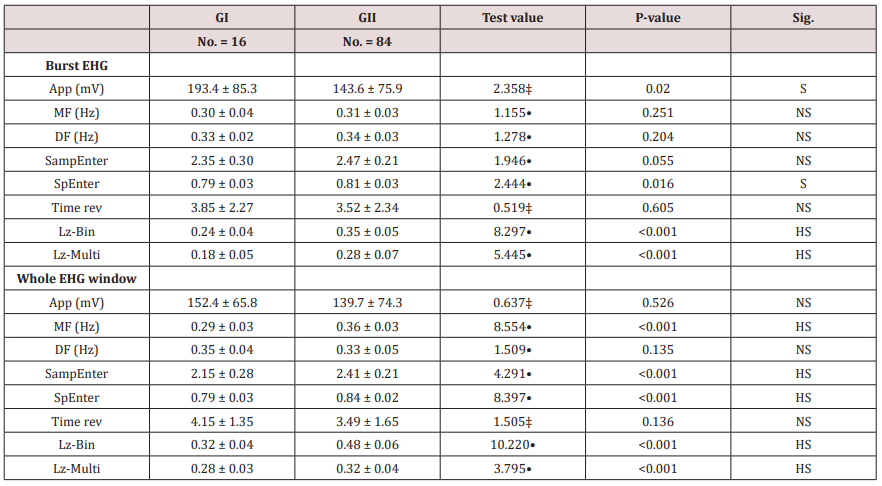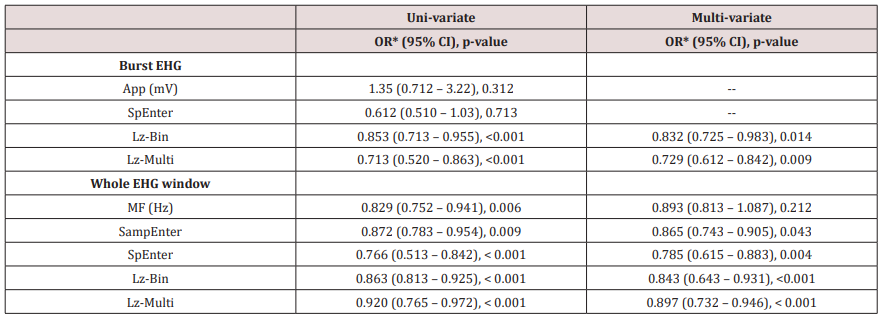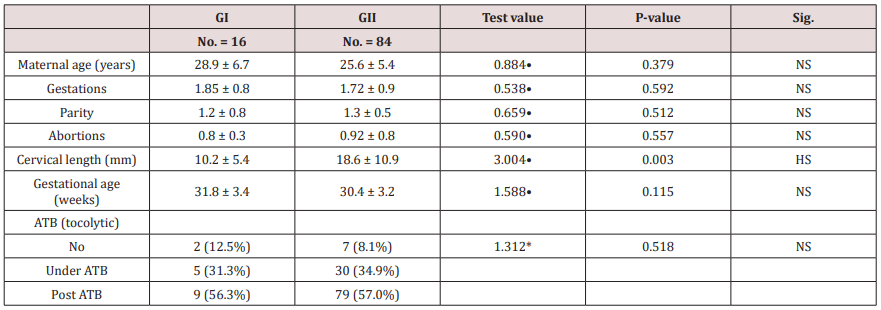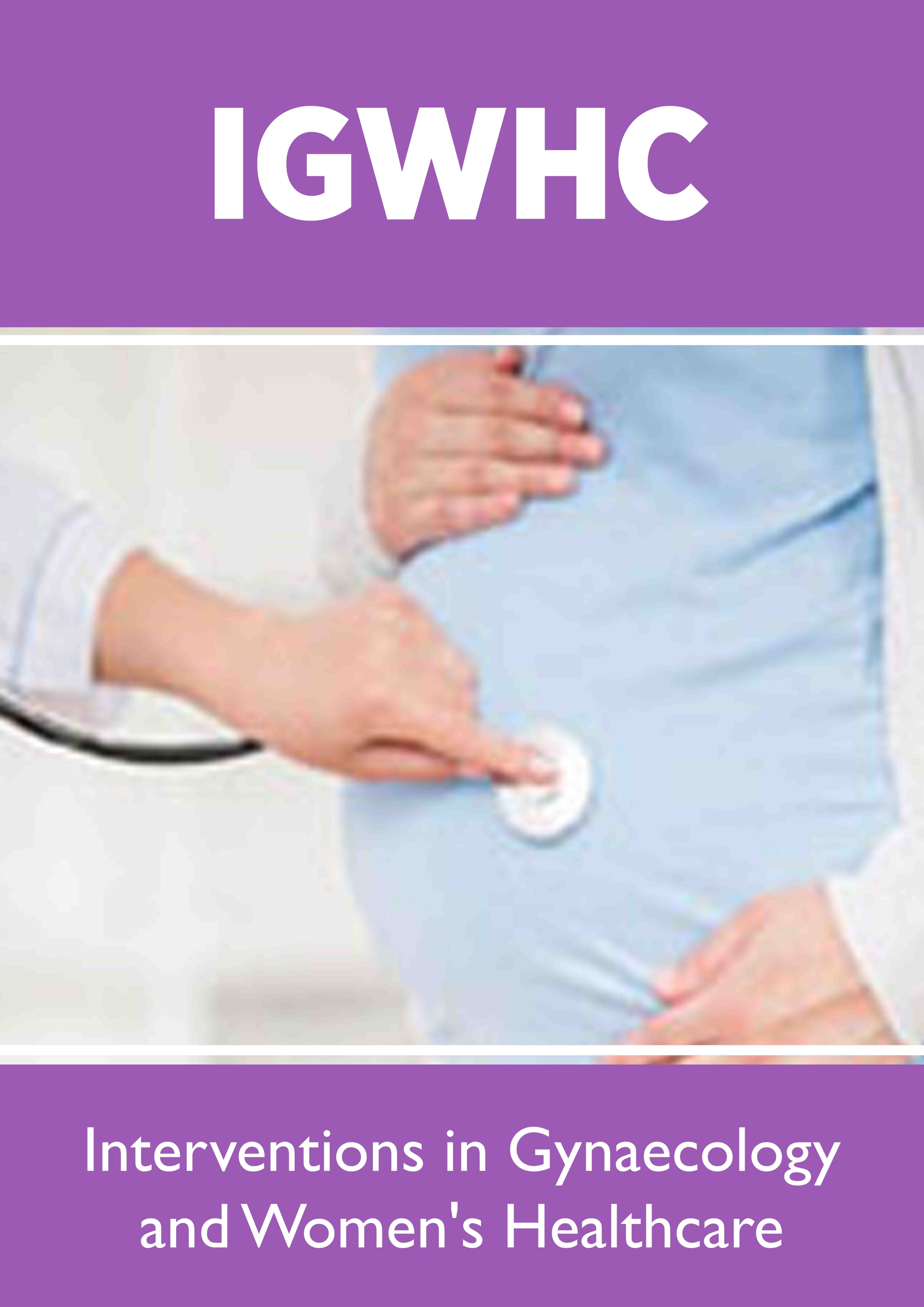
Lupine Publishers Group
Lupine Publishers
Menu
ISSN: 2637-4544
Research Article(ISSN: 2637-4544) 
Electro Hysterogram Parameters and Indices Clinical Applicability for Preterm Labor Management Volume 3 - Issue 3
Wael S Nossair*
- Department of Obstetrics and Gynecology, Zagazig University, Egypt
Received:June 21, 2019 ; Published: June 28, 2019
Corresponding author: Wael S Nossair, Department of Obstetrics and Gynecology, Zagazig University, Egypt
DOI: 10.32474/IGWHC.2019.03.000162
Abstract
Background: Prediction of threatened preterm labor is considered a major clinical challenge in obstetric every day practice usage of electro hysterography as an electro diagnostic tool to asses and the electrical activity levels within uterine muscle fibers could aid in management and predictability of delivery time in those category of cases.
Aim: To investigate the value of electro hysterogram indices to Predict delivery occurrence in more or less than 7 days threatened preterm cases under tocolytic management by usage of an electro hysterogram.
Methodology: A prospective clinical research trial conducted on 100 research study subjects having threatened preterm labor categorized in two research groups G1 research group have been composed of cases that delivered in less than 7 days after performing the electro hysterogram recording session G2 research group have been composed of cases that delivered after 7 days performing the electro hysterogram recording session.
Results: Burst EHG statistical significance was observed in Peak to peak amplitude of the EHG signals, Spectral entropy, Binary Lempel-Ziv index, Multistate Lempel-Ziv index (p values =0.020,0.016,<0.001,<0.001,consecutively) on the other hand regarding Whole EHG window statistical significant difference was observed in Median frequency: Sample entropy, Spectral entropy, Binary Lempel-Ziv index, Multistate Lempel-Ziv index (p values <0.001)
Conclusion: Uterine EMG is a promising tool as regards accuracy and value in prediction of true preterm labor even under tocolytic therapy that could show the effectiveness of tocolytic agent management. However future research studies should consider larger sample sizes in multicentric fashion and discriminate between various tocolytic agents’ impact on uterine muscular activity
Keywords: Uterine EMG; Preterm labor; Electro hysterogram
Introduction
Preterm labor one of the cornerstone clinical scenarios that affect the neonatal morbidity and mortality measuring the uterine activity is considered one of the chief management tools for assessing and evaluating preterm labor cases responsiveness to tocolytic management [1-3].
Tocodynamometer and intrauterine catheters are implemented measures having various draw backs such as re-positioning requirements their efficiency relies on the clinical sense providing no useful data uterine contractions effectiveness, that is crucial to elucidate for clinical diagnosis of true preterm labor however with current growing research interest is the uterine electromyography gaining interest for obstetricians all over the globe in evaluation of preterm labor contractions by assessing and interpreting uterine muscle fibers activity levels using an external approach for measurement of the uterine electrical activity levels, electro hysterography is an electro diagnostic tool that is used to asses and the electrical activity levels within uterine muscle fibers [4,5].
Electro hysterography acts by detectability of electric potential produced by muscle fibers. various prior research studies have revealed and displayed that uterine electrical activity levels are scarce and poorly coordinated at early gestational ages; on the other hand, it becomes progressively more powerful and coordinated as labor time approaches. the clinical applicability of this tool within obstetric wards requires further research efforts, as tocolytic agents are administered immediately after observation of threatened preterm labor therefore possibly causing uterine myoelectric activity impairment [6-8].
EHG parameters analysis and interpretation is required to predict the occurrence of preterm labor by clinical correlation to outcomes such as occurrence of established preterm labor and that issue in particular wasn’t sufficiently investigated by prior research groups [9-11].
Aim of the work
To investigate the value of electro hysterogram indices to Predict delivery occurrence in more or less than 7 days threatened preterm cases under tocolytic management by usage of an electro hysterogram. To do this, the results of classic electro hysterogram -burst analysis were compared with those from whole electro hysterogram window analysis.
Methodology
A prospective clinical research study involved electro hysterogram recording between 30 and 60 min on 100 research study subjects with singleton gestations. To investigate the EHG indices precision in diagnosing preterm labor in cases administered tocolytic agents That would give birth in less than 7 days, the evolution of various electro hysterogram indices have been statistically analyzed at various stages .G1 research group have been composed of cases that delivered in less than 7 days after performing the electro hysterogram recording session G2 research group have been composed of cases that delivered after 7 days performing the electro hysterogram recording session. Research subjects had Gestational ages 25 and 36 weeks clinically presenting with preterm labor symptoms and signs e.g. cervical effacement changes, nearly all of the recordings were conducted under the influence of tocolytic agents. The EHG signals were digitally filtered in the 0.1 to 4 Hz range, in which most of their spectral content is distributed, by a fifth order Butterworth bandpass digital. Both the classical EHG-burst and whole EHG windows were statistically analyzed.
Statistical Analysis
Data were collected, revised, coded and entered to the Statistical Package for Social Science (IBM SPSS) version 23. The quantitative data were presented as mean, standard deviations and ranges and compared between the two groups using Independent t-test when parametric and Mann-Whitney test when nonparametric. Also qualitative data were presented as number and percentages and compared using Chi-square test. Logistic regression analysis in the form of univariate and multivariate was used to assess the predictors of preterm delivery in burst and whole window of EHG. The confidence interval was set to 95% and the margin of error accepted was set to 5%. So, the p-value was considered significant at the level of < 0.05.
Table 1 reveals and displays the demographic research data of GI AND GII research groups in which there was no statistical significant difference between both research groups as regards maternal age ,gestations parity ,abortions gestational age in weeks ,absence under or post tocolytic agent therapy atosiban (p values=0.379, 0.592, 0.512, 0.557, 0.115, 0.518 consecutively) whereas cervical length was statistically significantly longer within GII research group (p value =0.003).
Table 2 reveals and displays Comparative statistical analysis between research group I (delivered less than 7 days) and research group II delivered more than 7 days) as regards results of burst EHG and whole EHG window in which concerning burst EHG statistical significance was observed in Peak to peak amplitude of the EHG signals, Spectral entropy, Binary Lempel-Ziv index, Multistate Lempel-Ziv index (p values =0.020, 0.016,<0.001, <0.001 consecutively) on the other hand regarding Whole EHG window statistical significant difference was observed in Median frequency: Sample entropy, Spectral entropy, Binary Lempel-Ziv index, Multistate Lempel-Ziv index (p values <0.001).
Table 2: Comparison between group I (delivered less than 7 days) and group II delivered more than 7 days) regarding results of burst EHG and whole EHG window.

•: Independent t-test; ‡: Mann-Whitney test; Bold Indicate Significant
App: Peak to peak amplitude of the EHG signals; MF: Median frequency; DF: Dominant frequency; SampEnter: Sample entropy; SpEnter: Spectral entropy; Time rev: Time reversibility; Lz-Bin: Binary Lempel-Ziv index; Lz-Multi: Multistate Lempel-Ziv index
Table 3: Uni-variate and multi-variate logistic regression analysis for significant parameters of burst EHG and whole EHG window in prediction of patients with pre-term delivery.

Bold Indicate Significant < 0.05
*: Odds ratio was adjusted for cervical length
App: Peak to peak amplitude of the EHG signals; SampEnter: Sample entropy; SpEnter: Spectral entropy; Lz-Bin: Binary Lempel-Ziv index; Lz-Multi: Multistate Lempel-Ziv index
Table 3 reveals and display the Uni-variate and multi-variate statistical logistic regression analysis for significant parameters of burst EHG and whole EHG window in predictability of patients with pre-term delivery in which burst EHG have shown by univariate statistical analysis statistical significance of Binary Lempel-Ziv index Multistate Lempel-Ziv index (p values<0.001) and by multivariate statistical analysis statistical significance of Binary Lempel-Ziv index, Multistate Lempel-Ziv index(p values=0.014,0.009,consecutively) whereas whole EHG window have shown by multivariate and univariate statistical analysis statistically significance of SpEnter: Spectral entropy, Binary Lempel-Ziv index, Multistate Lempel-Ziv index (most p values<0.001).
Discussion
Prediction of threatened preterm labor is considered a major clinical challenge in obstetric every day practice it was revealed and displayed that electro hysterography although complex in interpretation is an effective and accurate tool the could be implemented in practice .On the other hand this tool have not been adequately investigated in prior research studies and requires unification and standardization of analytic protocols since effectiveness of tocoltytic therapy in reducing preterm labor contractions could be accurately determined by electro hysterography [12,13].
Prior research groups of investigators have evaluated the capability of applying EHG data from threatened preterm labor cases revealing and displaying EHG-burst and whole EHG window amplitudes increases by approach of physiological process of labor that shows great harmony with the current research study findings [14].
Interestingly various previous researchers have shown that Spectral EHG content shifts towards Greater frequencies as labor approaches furthermore it was revealed that a valuable electro hysterography indices for predictability of preterm labor is dominant (or peak) frequency, That is displayed to be more elevated in cases that deliver prematurely [1,7,10].
Another research team in harmony with the current research study findings have revealed an interesting observation in which they have noticed that the dominant frequency for whole EHG window analysis, estimated within the frequency range 0.24-4Hz, can be implemented for discriminating between cases that deliver within 7 days from cases that delivered after 7 days. On the other hand, prior research studies denote that the median frequency could be implemented in discrimination and differentiation between full term from preterm labor, by whole EHG window and the EHG-burst that furthermore is in harmony with the current research study results. It was shown by various investigators that the existence of large amplitude fluctuations and spikes typical of EHG signals could influence the calculated sample entropy and signal regularity [2,5,9].
That raises the issue that standardization and unification of the measuring indices and protocols should be unified in future research efforts to maximize the possible clinical benefit of uterine electromyography , since computing factors, e.g. differences in bandwidth, the size of the analysis window, are affected artefacts caused by motion artifacts such as those caused by respiration [3,6,11].
Prior research studies investigating electrohystreography in a similar research approach and methodology to the current research study have revealed and displayed that both LZ-Bin and LZ-Multi are reliable indices for elucidating imminent labor and consequently could potentially be implemented practically as preterm labor prediction tools as revealed and displayed in the current research study findings [8,14].
Conclusion and Recommendation
Uterine EMG is a promising tool as regards accuracy and value in prediction of true preterm labor even under tocolytic therapy that could show the effectiveness of tocolytic agent management. However future research studies should consider larger sample sizes in multicentric fashion and discriminate between various tocolytic agents' impact on uterine muscular activity. Furthermore unification of the used indices and parameters obtained from uterine EMG in future research approaches to integrate the most valuable indices to relevant clinical data such as cervical length to aid in future innovation of predictability tools relying on clinical data and uterine EMG findings to elucidate cases that will go through preterm labor.
References
- Chkeir A, Fleury MJ, Karlsson B, Hassan M, Marque C (2013) Patterns of electrical activity synchronization in the pregnant rat uterus. Biomed 3: 140-144.
- Fergus P, Cheung P, Hussain A, Al Jumeily D, Dobbins C, et al. (2013) Prediction of preterm deliveries from EHG signals using machine learning. Plos one 8: e77154.
- American College of Obstetricians and Gynecologists and Committee on Practice Bulletins-Obstetrics (2012) Practice bulletin no. 127. Obstet Gynecol 119(6): 1308-1317.
- Hadar E, Biron Shental T, Gavish O, Raban O, Yogev Y (2015) A comparison between electrical uterine monitor, tocodynamometer and intra uterine pressure catheter for uterine activity in labor. J Matern Neonatal Med 28: 1367-1374.
- Hassan M, Terrien J, Marque C, Karlsson B (2011) Comparison between approximate entropy, correntropy and time reversibility: application to uterine electromyogram signals. Med Eng Phys 33: 980-986.
- Hassan M, Terrien J, Muszynski C, Alexandersson A, Marque C, et al. (2013) Better pregnancy monitoring using nonlinear correlation analysis of external uterine electromyography. IEEE Trans Biomed Eng 60: 1160-1166.
- Horoba K, Jezewski J, Matonia A, Wrobel J, Czabanski R, et al. (2016) Early predicting a risk of preterm labour by analysis of antepartum electrohysterograhic signals. Biocybern Biomed Eng 36: 574-583.
- Lemancewicz A, Borowska M, Kuć P, Jasińska E, Laudański P, et al. (2016) Early diagnosis of threatened premature labor by electrohysterographic recordings-the use of digital signal processing. Biocybern Biomed Eng 36: 302-307.
- M L WLM, LR C (2012) Noninvasive uterine electromyography for prediction of preterm delivery. Am J Obstet Gynecol 204: 1-20.
- Mischi M, Chen C, Ignatenko T, de Lau H, Ding B, et al. (2018) Dedicated entropy measures for early assessment of Pregnancy Progression From Single-Channel Electrohysterography. IEEE Trans Biomed Eng 65: 875-884.
- Rabotti C, Sammali F, Kuijsters N, Schoot B, Kortenhorst M, et al. (2015) Analysis of uterine activity in nonpregnant women by electrohysterography: a feasibilitystudy. In: Proc Annu Int Conf IEEE Eng Med Biol Soc EMBS pp. 5916–5919.
- Sikora J, Matonia A, Czabański R, et al. (2011) Recognition of premature threatening labour symptoms from bioelectrical uterine activity signals. Arch Perinat Med 17: 97-103.
- Vrhovec J, LebarAM (2012) An uterine electromyographic activity as a measure of labor progression. Appl EMG Clin Sport Med ,pp. 243-268.
- Ye Lin Y, Garcia Casado J, Prats Boluda G, Alberola Rubio J, Perales A (2014) Automatic identification of motion artifacts in EHG recording for robust analysis of uterine contractions. Comput Math Methods Med, p. 1-11.

Top Editors
-

Mark E Smith
Bio chemistry
University of Texas Medical Branch, USA -

Lawrence A Presley
Department of Criminal Justice
Liberty University, USA -

Thomas W Miller
Department of Psychiatry
University of Kentucky, USA -

Gjumrakch Aliev
Department of Medicine
Gally International Biomedical Research & Consulting LLC, USA -

Christopher Bryant
Department of Urbanisation and Agricultural
Montreal university, USA -

Robert William Frare
Oral & Maxillofacial Pathology
New York University, USA -

Rudolph Modesto Navari
Gastroenterology and Hepatology
University of Alabama, UK -

Andrew Hague
Department of Medicine
Universities of Bradford, UK -

George Gregory Buttigieg
Maltese College of Obstetrics and Gynaecology, Europe -

Chen-Hsiung Yeh
Oncology
Circulogene Theranostics, England -
.png)
Emilio Bucio-Carrillo
Radiation Chemistry
National University of Mexico, USA -
.jpg)
Casey J Grenier
Analytical Chemistry
Wentworth Institute of Technology, USA -
Hany Atalah
Minimally Invasive Surgery
Mercer University school of Medicine, USA -

Abu-Hussein Muhamad
Pediatric Dentistry
University of Athens , Greece

The annual scholar awards from Lupine Publishers honor a selected number Read More...






